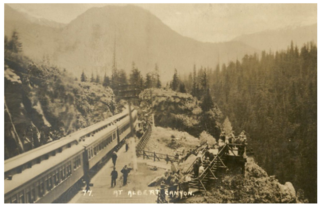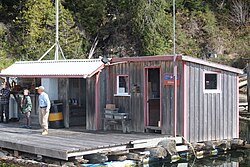
Rogers Pass is a high mountain pass through the Selkirk Mountains of British Columbia, but the term also includes the approaches used by the Canadian Pacific Railway (CP) and the Trans-Canada Highway. In the heart of Glacier National Park, this National Historic Site has been a tourist destination since 1886.
Eholt is in the Boundary Country region of south central British Columbia. This ghost town, on BC Highway 3, is by road about 27 kilometres (17 mi) northwest of Grand Forks and 14 kilometres (9 mi) northeast of Greenwood.

Holberg is a former ferry terminal about 35 kilometres (22 mi) from the northwest tip of Vancouver Island, British Columbia. This unincorporated community is at the head of Holberg Inlet, which forms the western arm of Quatsino Sound.

Midway is in the West Kootenay region of south central British Columbia. The village lies 13 kilometres (8 mi) west of Greenwood and 51 kilometres (32 mi) east of Osoyoos along Highway 3.
Donald is an unincorporated community in the East Kootenay region of southeastern British Columbia. This almost ghost town is on the northeast shore of the Columbia River immediately southeast of the mouth of Marl Creek. The locality, on BC Highway 1, is by road about 28 kilometres (17 mi) northwest of Golden and 122 kilometres (76 mi) northeast of Revelstoke.

Brookmere is an unincorporated community adjacent to Brook Creek in the Nicola region of southern British Columbia, in Canada. The former railway town, on Coldwater Rd, is by road about 44 kilometres (27 mi) south of Merritt.

Glacier, which once comprised small communities, is on the western approach to Rogers Pass in southeastern British Columbia. The name derives from the Great Glacier, which in the 1880s was just over a mile from the original train station.

Albert Canyon is a railway point in the West Kootenay region of southeastern British Columbia. The community was immediately east of the mouth of Albert Creek on the south shore of the Illecillewaet River. That settlement no longer exists, but the Canyon Hot Springs Resort borders to its north. On BC Highway 1, the locality is by road about 33 kilometres (21 mi) northeast of Revelstoke and 30 kilometres (19 mi) southwest of Glacier.
Palliser is a railway point which straddles the shores of the Kicking Horse River in the East Kootenay region of southeastern British Columbia. This ghost town, off BC Highway 1, is by road about 36 kilometres (22 mi) southwest of Field and 21 kilometres (13 mi) southeast of Golden.
Keefers is a railway point in the lower Fraser Canyon area of southwestern British Columbia. The ghost town is on the west shore of the Fraser River and north of the mouth of the Nahatlatch River. The locality is by rail about 82 kilometres (50.8 mi) north of Hope and 26 kilometres (15.9 mi) south of Lytton.
Thrums is an unincorporated community on the northwest shore of the Kootenay River in the West Kootenay region of southeastern British Columbia. The location, on BC Highway 3A, is by road about 11 kilometres (7 mi) northeast of Castlegar, and 33 kilometres (21 mi) southwest of Nelson.
Vallican is an unincorporated community on the west side of the Slocan River in the West Kootenay region of southeastern British Columbia. At the mouth of the Little Slocan River, the locality formerly spanned both sides of the Slocan River. The rural neighbourhood is off BC Highway 6 about 30 kilometres (19 mi) south of Slocan, and 39 kilometres (24 mi) north of Castlegar.
Niagara is on the west side of the Granby River, near the junction with Fisherman Creek, in the Boundary Country region of south central British Columbia. The small community is about 12 kilometres (7 mi) north of Grand Forks on North Fork Rd.
Paulson is a ghost town in the Boundary Country region of south central British Columbia. The locality, on the Paulson Detour Rd off Highway 3, is about 26 kilometres (16 mi) northeast of Christina Lake and 54 kilometres (34 mi) west of Castlegar.
Shushartie is a ghost town on the east shore of Shushartie Bay near the northeastern extremity of Vancouver Island, British Columbia.

Parson is an unincorporated community on the east shore of the Columbia River, in the Columbia Valley region of southeastern British Columbia. The locality, on BC Highway 95, is by road about 212 kilometres (132 mi) north of Cranbrook and 35 kilometres (22 mi) southeast of Golden.
Harry Bruce Johnston was a Canadian politician, who served in the Legislative Assembly of British Columbia.
Zamora is on the west side of the Kettle River in the Boundary region of south central British Columbia. The rural settlement, on BC Highway 33, is by road about 12 kilometres (7 mi) north of Rock Creek and 124 kilometres (77 mi) southeast of Kelowna.
Beavermouth is about 43 kilometres (27 mi) west of Golden, and about 32 kilometres (20 mi) east of the mid-point of the Connaught Tunnel beneath Rogers Pass, in southeastern British Columbia. At the mouth of the Beaver River, the train station was called Beavermouth, but the adjacent community, which no longer exists, was known as Beaver or Beaver Mouth. Nowadays, the closest road access is to the nearby Kinbasket Lake Resort.
Redgrave siding is about 35 kilometres (22 mi) west of Golden, and about 40 kilometres (25 mi) east of the mid-point of the Connaught Tunnel beneath Rogers Pass, in southeastern British Columbia. Accessible by road in the summer months, the former small railway community is long gone. The highway turnoff is at the Redgrave Rest Area.







